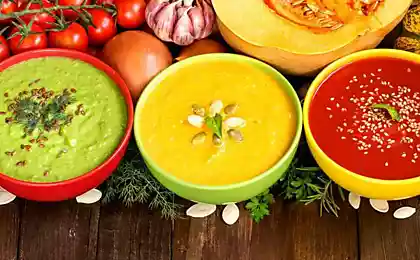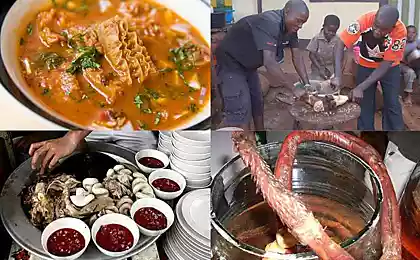191
Why not all Georgian chefs consider harcho soup
How to make harcho soup is not as simple as it may seem at first. Not all Georgians consider harcho to be soup. It is believed that in the first dishes it was once mistakenly recorded by the compilers of Soviet cookbooks.

It happens so often with Caucasian cuisine. It does not fit all its diversity into the simple European scheme “first – second”. Here, for example, what Boris Burda writes about fragrant and hearty chanakhis: “Do not ask me what chanakhi is – soup or a second dish.” I don't know. In the thickness it is somewhere in the middle.
But back to our sheep. More specifically, lamb. Is it possible to make a real harcho from it? Someone, remembering Pokhlebkin, will say: “No, harcho is made only from beef!” But let us turn to the classic of Georgian cuisine Tamara Platonovna Sulakvelidze.

In her book Georgian Dishes, we find harcho from beef, lamb, poultry, fish and even without any meat. In short, diametrically opposed views on harcho abound.
Therefore, may the admirers of original recipes forgive us, we will talk about the intricacies of cooking harcho, based on the recommendations of the famous chef Ilya Latherson.
Cooking harcho from anything but beef, Ilya Isaakovich considers a mistake. In his opinion, it is best to choose for this brisket and ribs.

Add to the meat sliced onions with husks, stems of celery and boil everything to the softness of the meat.
Sour and Harcho's hair is sour soup. But Latherson doesn’t recommend using tomatoes. Make a cruciform incision on a small fresh tomato and scald it in boiling broth. Then dip in cold water and remove the skin. Cut the tomatoes with slices.

Remove the seeds. Cut the tomato flesh with cubes and the onions with quarters of rings. Heat the vegetable oil in the pan and pass the onions in it. Add to the onions crushed tomatoes and half a tablespoon of tomato puree (for color).
Remove onions and celery from the broth. Pour fried onions and tomatoes. Save it to taste. It is time to add two tablespoons (to taste) of tkemali sauce, which will be responsible for sourness in harcho.

The hot pepper will add to the harcho. It should be cut in small pieces and added to a pot of soup.
Rhys There must be rice in the harcho. But with a long cooking, it tends to turn into porridge. Two rules follow.

First of all, you should not overdo it with rice. One handful is enough. Secondly, it is better to eat harcho on the same day it is cooked.
Latherson strongly recommends using the most Georgian grass - cilantro. I do not recommend adding walnuts. Cut the leaves and stems of cilantro, parsley leaves, celery leaves. Crush with a knife 3-4 cloves of garlic.

Before the soup is ready, send rice to it. Add utskho-suneli (fenugreek), ground coriander, chaber, some adjiki, a mix of dry peppers.
Wait for the rice ready, turn off the gas, pour crushed herbs and immediately cover the soup with a lid. After that, the harcho should be infused for 15-20 minutes.

Earlier, we shared with readers the recipe of the signature soup harcho from the magnificent Roxana Babayan. In any case, harcho soup turns out thick, brewy and very tasty.
In the cold season especially want warmth, care and something tasty. And the best way to get it all at once is to make a warming soup.

It happens so often with Caucasian cuisine. It does not fit all its diversity into the simple European scheme “first – second”. Here, for example, what Boris Burda writes about fragrant and hearty chanakhis: “Do not ask me what chanakhi is – soup or a second dish.” I don't know. In the thickness it is somewhere in the middle.
But back to our sheep. More specifically, lamb. Is it possible to make a real harcho from it? Someone, remembering Pokhlebkin, will say: “No, harcho is made only from beef!” But let us turn to the classic of Georgian cuisine Tamara Platonovna Sulakvelidze.

In her book Georgian Dishes, we find harcho from beef, lamb, poultry, fish and even without any meat. In short, diametrically opposed views on harcho abound.
Therefore, may the admirers of original recipes forgive us, we will talk about the intricacies of cooking harcho, based on the recommendations of the famous chef Ilya Latherson.
Cooking harcho from anything but beef, Ilya Isaakovich considers a mistake. In his opinion, it is best to choose for this brisket and ribs.

Add to the meat sliced onions with husks, stems of celery and boil everything to the softness of the meat.
Sour and Harcho's hair is sour soup. But Latherson doesn’t recommend using tomatoes. Make a cruciform incision on a small fresh tomato and scald it in boiling broth. Then dip in cold water and remove the skin. Cut the tomatoes with slices.

Remove the seeds. Cut the tomato flesh with cubes and the onions with quarters of rings. Heat the vegetable oil in the pan and pass the onions in it. Add to the onions crushed tomatoes and half a tablespoon of tomato puree (for color).
Remove onions and celery from the broth. Pour fried onions and tomatoes. Save it to taste. It is time to add two tablespoons (to taste) of tkemali sauce, which will be responsible for sourness in harcho.

The hot pepper will add to the harcho. It should be cut in small pieces and added to a pot of soup.
Rhys There must be rice in the harcho. But with a long cooking, it tends to turn into porridge. Two rules follow.

First of all, you should not overdo it with rice. One handful is enough. Secondly, it is better to eat harcho on the same day it is cooked.
Latherson strongly recommends using the most Georgian grass - cilantro. I do not recommend adding walnuts. Cut the leaves and stems of cilantro, parsley leaves, celery leaves. Crush with a knife 3-4 cloves of garlic.

Before the soup is ready, send rice to it. Add utskho-suneli (fenugreek), ground coriander, chaber, some adjiki, a mix of dry peppers.
Wait for the rice ready, turn off the gas, pour crushed herbs and immediately cover the soup with a lid. After that, the harcho should be infused for 15-20 minutes.

Earlier, we shared with readers the recipe of the signature soup harcho from the magnificent Roxana Babayan. In any case, harcho soup turns out thick, brewy and very tasty.
In the cold season especially want warmth, care and something tasty. And the best way to get it all at once is to make a warming soup.























